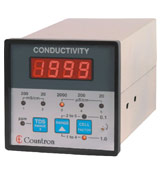A Conductivity meter is used to measure the amount electrical current in a solution. This electric device is used for determining the purity of water. Water treatment plants use this meter to measure the changes in the wastewater procedures as these are the common measuring instrument used for monitoring the situation in any water treatment plant.

How a Conductivity Meter Works?
A Conductivity meter is usually consists of a probe which is used for measurements. This probe is placed in the liquid to be measured and the meter applies the voltage between the two electrodes inside the probe. The meter reads the drop in the voltage caused by the electrical resistance from the solution.
5 Important Features To Consider While Selecting a Conductivity Meter
Here are some important featured discussed which you have to keep in mind while looking for a good conductivity meter.
- Temperature Compensation: A cell with an in-built temperature sensor which allows the meter to make the adjustments to the TDS readings or conductivity based on the changes in the solution temperature.
- TDS Conversion Factor: It is needed to adjust the TDS reading automatically when a solution does not have similar ionic content to salt or natural water.
- Adjustable Temperature Coefficients: A change in temperature affects the pure water and alcohols. This feature allows the user to compensate for the properties of the measured solution.
- Autoranging: There is no need to change the range manually. The meter will automatically select the accurate range for the measurement.
- Adjustable cell constant: This adjusts the measurement to reflect the use of a cell with a constant.
Temperature Dependence of a Conductivity Meter
The reading of the conductivity meter is usually depending on temperature then increase in temperature will lead to increase in its conductivity. The reading may be inaccurate because the conductance and ionic strength is temperature dependent. Therefore many of the conductivity meters come with the specific conductance measurement. When the meter is in the specific conductance mode, it reads the solution’s conductivity at 25-degree Celsius instead of reading at the actual temperature. This produces more standard and accurate readings.
Calibration of the Conductivity Meter
The calibration of a meter leads to reliable and accurate results. If you want to need to calibrate your meter, you have to follow the simple instructions for that meter. The meter will have a menu item that will allow you to enter the calibration mode.
Salinity and Total Dissolved Solids
Salinity is the measure of dissolved salts in a solution. Conductivity meters are internally equipped with the salinity option which converts the conductivity reading to one of the salinity. According to the reports of Washington State’s Department of Ecology, the freshwater bodies should have a much lower concentration of salinity than the ocean water which is generally estimated between the 20 and 30 parts per trillion.
Read More Blogs: What Is The Importance Of A Data Logger